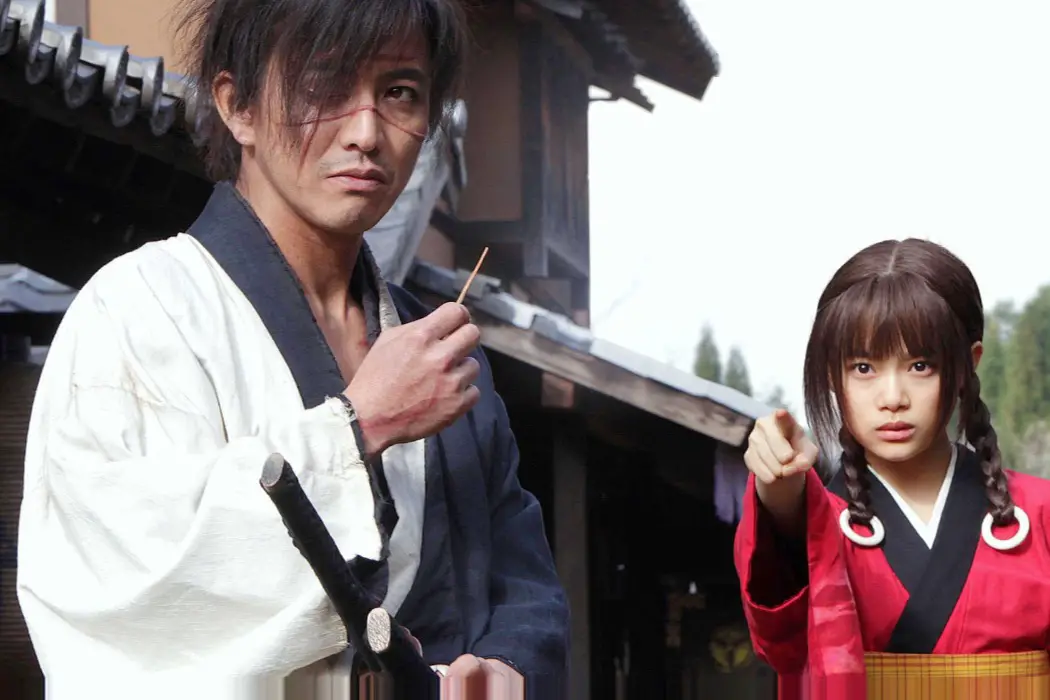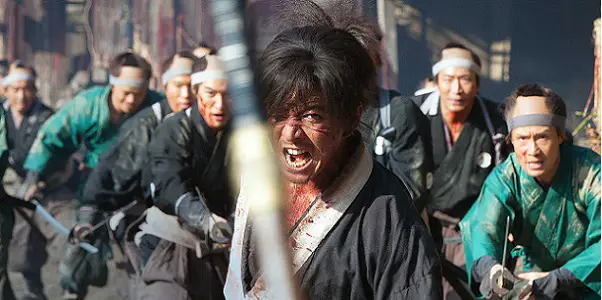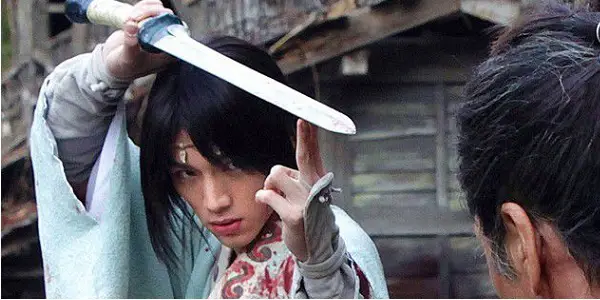BLADE OF THE IMMORTAL: 100th Time, Still The Gory Charm

Hazem Fahmy is a poet and critic from Cairo. He…
You can’t be neutral about Takashi Miike. His penchant for over-the-top violence, mixed with surprisingly grounded stories that center around violent men figuring out their place in the world, is not for everyone. But, my God, when you take the man on his own terms you’re in for a world of delight, and a whole lot of gore. Blade of the Immortal is his latest blood-soaked gift to us, and it’s nothing if not a spectacular refinement of the prolific auteur’s finest strengths.
Adapted from the popular eponymous manga, Blade of the Immortal follows Manji, an archetypical Miike hero, played by a brooding and empathetic Takuya Kimura. A masterful samurai, Manji gets himself in deep trouble when he takes out the corrupt warlord he used to serve under, killing his sister’s husband in the process. The story begins with the two siblings travelling together. From the get-go, Miike wastes no time establishing their dynamic. Manji is overcome with guilt for what his actions have done to his sister’s sanity, and he now finds little reason to live beyond the need to protect her from further harm. Of course, he fails spectacularly as a small army of ronin out for his bounty ambush him and murder Machi to get to him.
Born to Kill
Naturally, he slaughters them all within minutes. As he lies dying on the ground, a mysterious nun appears and implants “bloodworms” into his body. The creatures heal his body back together and make him, as you might have picked up from the title, immortal. Fifty years later, Manji is living in pain, but also relative peace, on the outskirts of Edo when a young girl, Rin Asano, played fiercely by Hana Sugisaki, finds him and pleads for his help in her quest to avenge her father. From there on, it’s business as usual for Miike, who pulls out all the stops you might expect of a fantastical samurai revenge flick.

The highlight is, of course, the fighting. Blade’s battles are gorgeous and brutal. Most of them take place in lush environments on the outskirts of the city, creating a stunning contrast between the tranquil landscapes and the epic violence. Nearly every single fight is memorable, whether for its awesome choreography, well-balanced humor or significant character development. Though spectacle is essential to the film’s pacing and aesthetic, fights still feel significantly character-driven. This is reflected in cinematographer Nobuyasu Kita’s consistent use of medium shots during action sequences, keeping us locked onto each character as the carnage unfolds around them. Establishing shots are rarely used, but when they are, it’s after the battle’s done and the blood has sunk into the Earth.
Like much of Miike’s work, Blade’s violence, fun as it is, transcends its own exaggeration, subverting along the way what we come to expect out of such a hack-n’-slash filled flick. When the action slows down and we get to spend time with Manji and Rin, Blade of the Immortal becomes a meditation on the nature of vengeance; its temptation and ultimate futility. The age-old question, where does it end, is prominent here, but it’s also given new life by the fact that Manji cannot escape life. Your average revenge-seeking warrior is bound by death, a guaranteed end after which they have no choice but to rest. Manji receives no such mercy. As he repeats throughout the film, others are lucky that they can die.
Violence Begets Violence
This struggle with the nature of violence is only heightened by the historical setting, in which a shaky system of power leaves political players with many enemies and few allies to trust. Miike plays with said setting brilliantly, both in aesthetic as well as thematic ways. His penchant for theatricality is as pervasive as always, but it’s more toned down here (at least relatively) creating a comprehensive fantastical spin on the setting. Toshiyuki Matsumiya’s superb production design brings the Tokugawa period to life seamlessly, only to disrupt it later with a colorful cast of assassins who look fresh off a time machine. Still, historical inaccuracy aside, every lavish costume and outlandish character design fits.

The story feels aptly fit for the period given the turbulent nature of the Shogunate. Violence is an inherent part of military dictatorship and its ubiquity looms over the narrative. Every single character is practically always expecting a fight, and though this may work fine for the youthful antagonist, Sota Fukushi’s smug yet terrifying Kagehisa Anotsu, it’s exhausting for Manji. He has grown tired of fighting yet can’t seem to stop, at least not any time soon. Hey may be immortal, but violence is timeless, consuming everything he’s ever known.
Despite the plot’s generally brisk pace, the film did drag a tad more than it needed to. Though no sequence in particular feels criminally stretched throughout the hefty two hour and a half runtime, some expository dialogue, especially dramatic pre-fight speeches, could’ve been trimmed a bit. Still, it wouldn’t be Miike without that kind of intense extravagance.
Verdict: Blade of the Immortal
Though far from revolutionary, Blade of the Immortal is a stand-out, subversive work more than fit to hold the mantle of Miike’s hundredth film. We are so lucky he is only fifty-seven years old. Here’s hoping he sticks around the biz long enough for number two-hundred.
What is your favorite fantasy-samurai film?
Blade of the Immortal is currently in select theaters in the U.S. For a list of full release dates, see here.
Does content like this matter to you?
Become a Member and support film journalism. Unlock access to all of Film Inquiry`s great articles. Join a community of like-minded readers who are passionate about cinema - get access to our private members Network, give back to independent filmmakers, and more.
Hazem Fahmy is a poet and critic from Cairo. He is an Honors graduate of Wesleyan University’s College of Letters where he studied literature, philosophy, history and film. His work has appeared, or is forthcoming in Apogee, HEArt, Mizna, and The Offing. In his spare time, Hazem writes about the Middle East and tries to come up with creative ways to mock Classicism. He makes videos occasionally.













